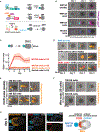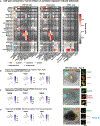Synthetic organizer cells guide development via spatial and biochemical instructions
- PMID: 39706189
- PMCID: PMC12027307
- DOI: 10.1016/j.cell.2024.11.017
Synthetic organizer cells guide development via spatial and biochemical instructions
Abstract
In vitro development relies primarily on treating progenitor cells with media-borne morphogens and thus lacks native-like spatial information. Here, we engineer morphogen-secreting organizer cells programmed to self-assemble, via cell adhesion, around mouse embryonic stem (ES) cells in defined architectures. By inducing the morphogen WNT3A and its antagonist DKK1 from organizer cells, we generated diverse morphogen gradients, varying in range and steepness. These gradients were strongly correlated with morphogenetic outcomes: the range of minimum-maximum WNT activity determined the resulting range of anterior-to-posterior (A-P) axis cell lineages. Strikingly, shallow WNT activity gradients, despite showing truncated A-P lineages, yielded higher-resolution tissue morphologies, such as a beating, chambered cardiac-like structure associated with an endothelial network. Thus, synthetic organizer cells, which integrate spatial, temporal, and biochemical information, provide a powerful way to systematically and flexibly direct the development of ES or other progenitor cells in different directions within the morphogenetic landscape.
Keywords: developmental biology; differential adhesion; gastruloid; morphogen gradient; regenerative medicine; signaling center; synCAMs; synthetic biology; synthetic cell adhesion molecules; synthetic embryos; synthetic organizer.
Copyright © 2024. Published by Elsevier Inc.
Conflict of interest statement
Declaration of interests B.G.B. is a founder and shareholder of Tenaya Therapeutics. W.A.L. is a shareholder of Gilead Sciences, Intellia Therapeutics, Allogene Therapeutics, and SciFi Foods. W.A.L. has been an advisor to Cell Design Labs, Kite Therapeutics, Allogene Therapeutics, and SciFi Foods; is on the Board of the Burroughs Wellcome Fund; and is on the Editorial Board of Cell. T.Y., C.T., J.M.B., A.J.S., O.D.K., and W.A.L. have applied for patents related to this work.
Figures







References
-
- Spemann H, and Mangold H (1924). über Induktion von Embryonalanlagen durch Implantation artfremder Organisatoren. Arch. Für Mikrosk. Anat. Entwicklungsmechanik 100, 599–638. 10.1007/BF02108133. - DOI
MeSH terms
Substances
Grants and funding
LinkOut - more resources
Full Text Sources
Research Materials

